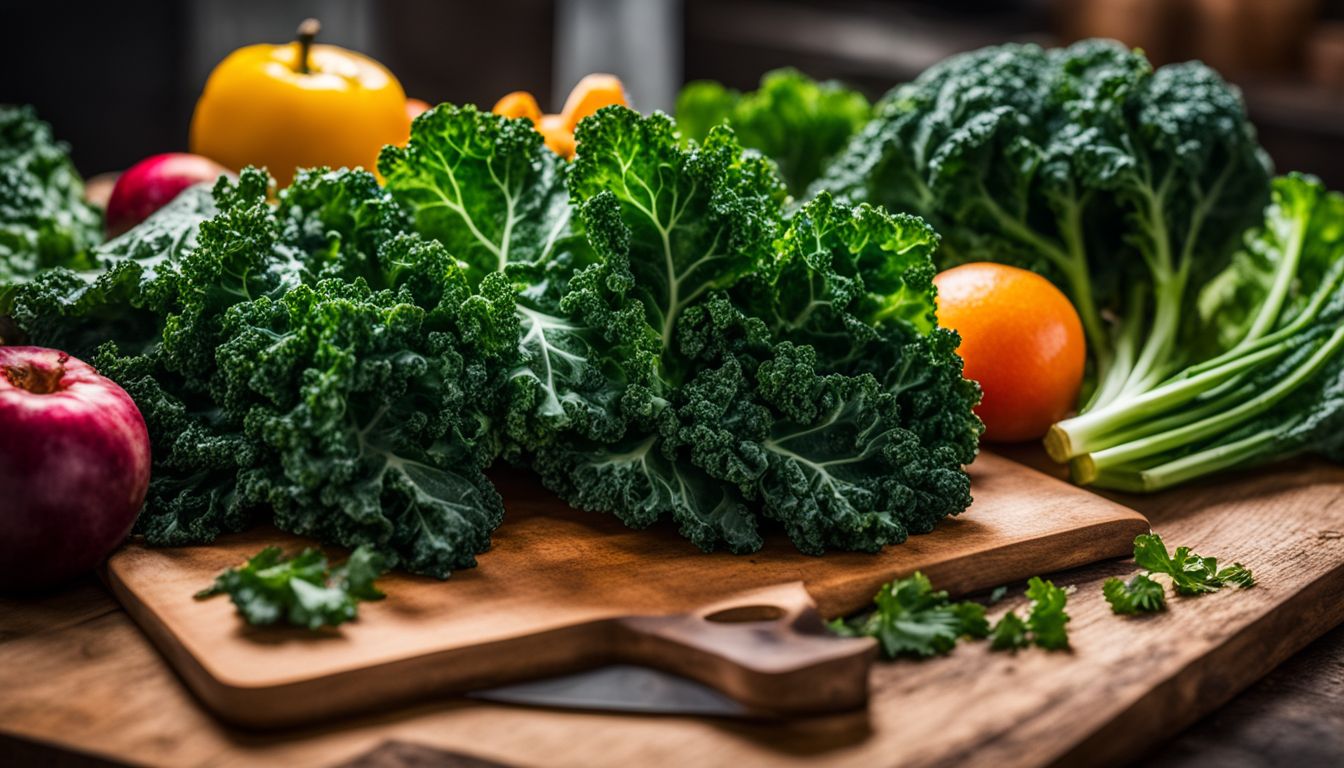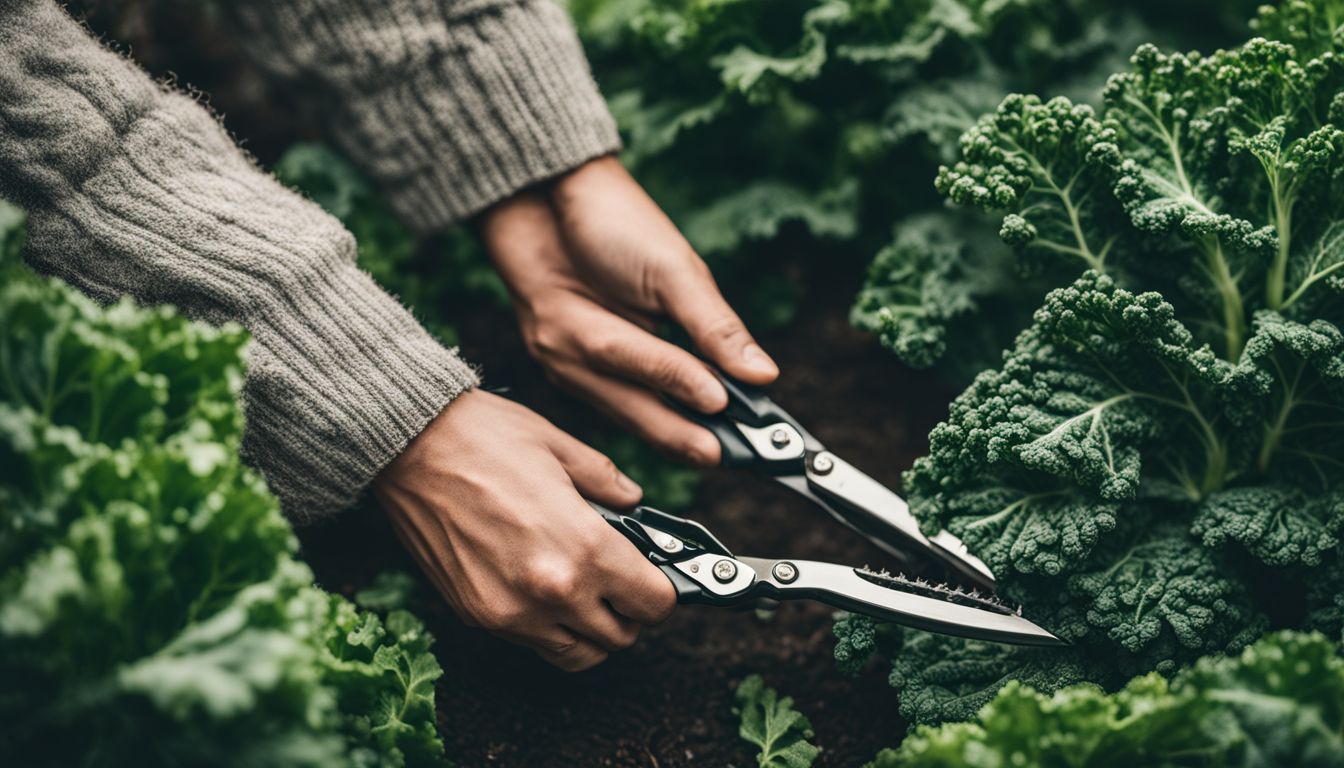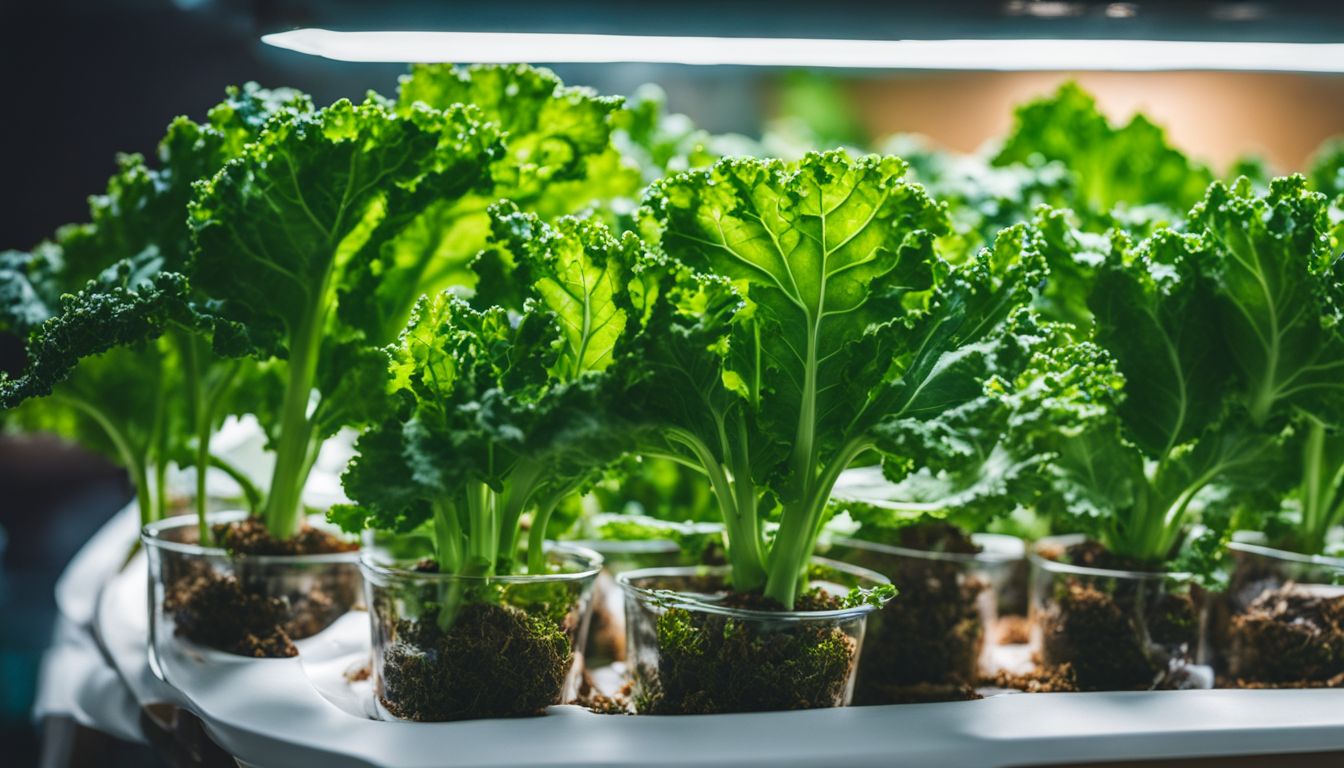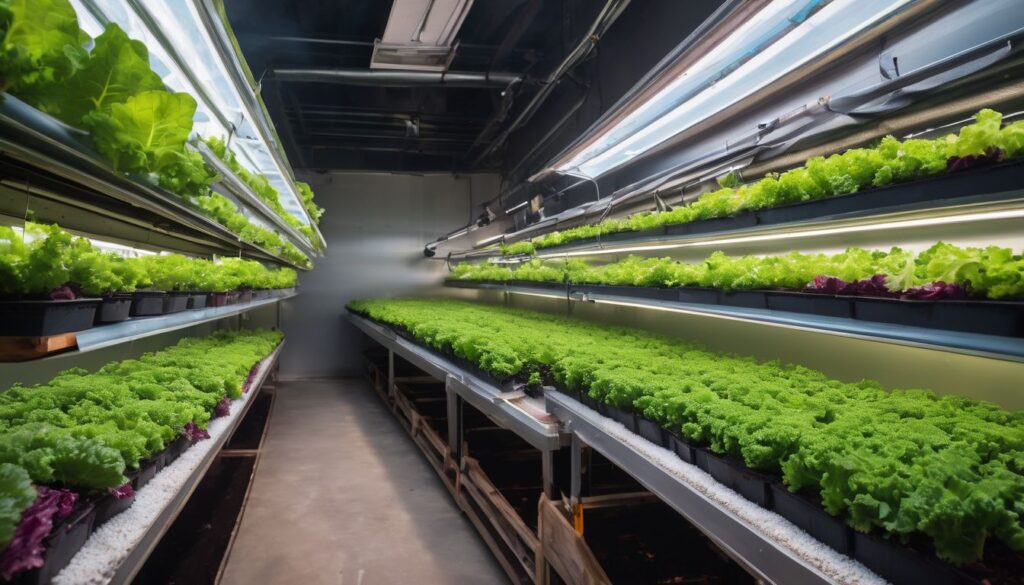Frustrated with your kale wilting in traditional soil gardening? Here’s a little-known fact, kale is one of the best plants to grow in an aquaponics system. This blog will guide you step by step on how to successfully grow kale in aquaponics. We will dive through all stages of growing lush, nutrient-rich kale using this innovative method.
Read on for the greenest thumb on your block!
Key Takeaways
- Kale is an ideal plant to grow in aquaponics systems due to its fast growth rate, high nutrient content, and tolerance of varying pH levels.
- Aquaponics is a smart system that uses fish waste to provide nutrients for plants like kale, while the plants help clean the water for the fish.
- To successfully grow kale in aquaponics, choose the right variety, provide ideal growing conditions (temperature, pH level, sunlight), monitor water quality and nutrient levels regularly, and address common issues such as nutrient deficiencies or pests.
What is Aquaponics and How Does it Work?
 Aquaponics is a smart way to grow plants and fish together. It uses water from a fish tank to help plants grow. Fish waste has nutrients that the plant needs to grow well. In return, the plant cleans the water for the fish.
Aquaponics is a smart way to grow plants and fish together. It uses water from a fish tank to help plants grow. Fish waste has nutrients that the plant needs to grow well. In return, the plant cleans the water for the fish.
Water from the fish tank goes into a growing bed where it feeds plants like kale. The roots of these plants soak up excess nutrients in this water. This process makes the water clean again before it goes back to the fish tank.
So, in an aquaponic system, both plants and fish help each other live well. Kale grows quite fast in such systems as per important fact no 5.
Why Kale is a Great Plant to Grow in Aquaponics

Kale is an excellent plant choice for aquaponics due to its fast growth rate, high nutrient content, and tolerance of varying pH levels.
Fast growth rate

Kale has a fast growth rate, making it an ideal plant to grow in aquaponics systems. In just a few weeks, you can see significant growth and be able to harvest the leaves for your consumption.
This means that you can enjoy fresh kale from your aquaponics system much quicker compared to growing it in traditional soil gardens. With its rapid growth, you can have a steady supply of nutritious kale throughout the year.
High nutrient content

Kale is an excellent plant to grow in aquaponics because it has a high nutrient content. It is packed with vitamins and minerals like vitamin K, vitamin C, calcium, and potassium. These nutrients are essential for our bodies to stay healthy and strong.
By growing kale in aquaponics, you can ensure that you’re getting fresh, nutritious greens that have been grown without the use of harmful chemicals or pesticides. Plus, since kale grows quickly in aquaponics systems, you can enjoy its nutrient-rich leaves all year round.
So not only does kale taste great in salads or smoothies but it also provides numerous health benefits as well.
Tolerant of varying pH levels

Kale is a great plant to grow in aquaponics because it is tolerant of varying pH levels. This means that it can thrive even if the pH of the water in your system fluctuates. Unlike other plants that may struggle with changes in pH, kale can handle these variations without much trouble.
This makes it easier for aquaponic growers to maintain the right conditions for their plants and ensures that kale can continue to grow well in this type of system. So, if you’re considering growing kale in aquaponics, you don’t have to worry too much about keeping the pH level consistent all the time.
How to Successfully Grow Kale in Aquaponics

Learn the key steps, from choosing the right variety to monitoring water quality, for a successful kale harvest in your aquaponics system. Keep reading to discover the secrets of thriving kale plants in this innovative growing method.
Choosing the right variety of kale

There are several varieties of kale that you can choose from to grow in your aquaponics system. One popular variety is the curly kale, which has a textured and frilly appearance. Another option is the Tuscan kale, also known as Lacinato or Dinosaur kale, which has long and flat leaves.
Red Russian kale is another choice, with its purple stems and softer leaves. Each variety has its own unique taste and texture, so it’s important to consider your preferences when choosing which one to grow.
Additionally, some varieties may be more tolerant of certain growing conditions than others, so take into account factors like temperature and pH levels when making your decision.
– Providing the ideal growing conditions (temperature, pH, sunlight)
To successfully grow kale in aquaponics, it’s crucial to provide the plant with the right growing conditions. Kale thrives in temperatures between 60°F and 75°F (15°C – 24°C), so make sure to maintain a consistent temperature within this range.
Providing the ideal growing conditions (temperature, pH, sunlight)
-831e85fd5c-309707304.jpg)
To ensure successful growth of kale in aquaponics, it is important to provide the ideal growing conditions. Kale thrives in temperatures between 60-75°F (15-24°C). It requires at least 6 hours of direct sunlight each day, but can tolerate partial shade.
The pH level of the water should be maintained between 6.0 and 7.5 for optimal growth. Keeping these factors in balance will help your kale plants grow strong and healthy, providing you with a bountiful harvest throughout the year.
Monitoring water quality and nutrient levels

To successfully grow kale in an aquaponics system, it’s important to monitor the water quality and nutrient levels regularly. Testing the pH level of the water is crucial, as kale prefers a slightly acidic environment with a pH range between 6.0 and 7.0.
Regularly check and adjust the nutrient levels in the system to ensure that they are adequate for healthy plant growth. This can be done by testing the ammonia, nitrite, and nitrate levels in the water; maintaining proper balance is key.
By keeping an eye on these factors, you can ensure that your kale plants receive optimal conditions for growth and development.
Pruning and harvesting techniques

Pruning and harvesting techniques play a crucial role in growing kale in aquaponics. To maintain healthy growth, it is important to regularly prune the outer leaves of the plant, allowing the inner leaves to receive enough sunlight and nutrients.
When harvesting kale, you can either selectively pluck individual leaves or cut the entire plant at once. It’s best to harvest mature leaves while leaving a few inches of growth at the base for regrowth.
This way, you can enjoy a continuous supply of fresh kale from your aquaponics system throughout the year.
Common Issues and Troubleshooting Tips for Growing Kale in Aquaponics

Identifying and addressing nutrient deficiencies, pests and diseases, as well as maintaining a balanced system are essential for successful growth of kale in aquaponics.
Nutrient deficiencies and excesses

Kale grown in aquaponics systems may sometimes experience nutrient deficiencies or excesses. This can happen if the fish waste does not provide enough nutrients for the plants, or if there is an imbalance in the system.
Nutrient deficiencies can lead to stunted growth, yellowing leaves, and poor overall health of the kale plants. On the other hand, nutrient excesses can cause nutrient burn, where the leaves turn brown and crispy.
To prevent these issues, it is important to monitor water quality and nutrient levels regularly. Adjustments may need to be made by adding additional nutrients or adjusting feeding schedules for the fish.
Pests and diseases

Pests and diseases can be a challenge when growing kale in aquaponics. Some common pests that may affect kale include aphids, caterpillars, and whiteflies. To prevent these pests, it’s important to regularly inspect your plants and take action at the first sign of infestation.
This can include manually removing the pests or using organic pest control methods such as neem oil or insecticidal soap. In terms of diseases, kale is susceptible to fungal infections such as powdery mildew and downy mildew.
To prevent these diseases, make sure to provide adequate air circulation around your plants by spacing them properly and avoiding overwatering. Additionally, maintaining proper nutrient balance in your aquaponics system can help strengthen the plants’ natural defenses against diseases.
Imbalanced system

An imbalanced system is a common issue faced when growing kale in aquaponics. This happens when the nutrient levels in the water are not properly balanced, leading to deficiencies or excesses that can harm the plants.
Nutrient deficiencies can result in stunted growth and yellowing leaves, while excess nutrients can cause toxicity and leaf burn. It is important to monitor the water quality and nutrient levels regularly to maintain a healthy balance for optimal kale growth.
Additionally, an imbalanced system can also be caused by other factors such as pH levels, temperature fluctuations, or inadequate sunlight exposure. Troubleshooting tips include adjusting the nutrient solution, testing and adjusting pH levels if necessary, providing adequate lighting conditions, and ensuring proper water circulation within the aquaponics system.
Conclusion

Growing kale in aquaponics is a great way to have a constant supply of this nutritious leafy green. With its fast growth rate, high nutrient content, and tolerance of varying pH levels, kale thrives in aquaponics systems.
By choosing the right variety, providing ideal growing conditions, and monitoring water quality and nutrient levels, you can successfully grow kale year-round. Don’t forget to address any common issues like nutrient deficiencies or pests that may arise.
Happy growing!
FAQs
1. What is unique about growing kale in aquaponics?
Growing kale in aquaponics allows for year-round crop cultivation and easy-to-maintain plants, making it a part of sustainable agriculture.
2. How does hydroponic kale differ from soil gardeners’ grown kale?
Hydroponic kale is hardy, harvested from indoor microclimates instead of outdoor soils. It also grows faster due to the nutrient-rich fish water used from Nile tilapia or other aquatic plants.
3. Is growing lettuce similar to producing hydroponically grown kale?
Yes! Like lettuce, you can grow hydroponic kale easily because both are leafy greens with high nutritional profile suitable for urban farming methods such as aquaponics.
4. Are there any other crops that I could grow in my hydroponic system apart from Kale?
Certainly! Apart from leafy greens like lettuce and radish too can be cultivated using these same methods attention should just be given to their required number of leaves and sturdiness
5.How does an Aquaponics system work?
The Aquaponics systems use a method called nutrient cycling its where nutrients released by the fish feed both your vegetable crops which in turn cleans the water for reuse by fish it’s organic farming at its peak

As a dedicated mother and passionate software developer, she weaves her diverse experiences into captivating stories that inspire and engage readers. Emma's love for sustainable living and environmental consciousness permeates both her personal and professional life. When she's not immersed in the world of coding and software development, Emma can be found nurturing her family and tending to her thriving organic garden. Her commitment to sustainable practices extends to every aspect of her life, from repurposing household items to embracing eco-friendly technologies.










